Business Communication: Addressing Barriers to COVID-19 Vaccination
VerifiedAdded on 2023/06/18
|9
|2237
|300
Report
AI Summary
This report examines the role of business communication in addressing the challenges of vaccine hesitancy and low vaccination rates. It identifies key communication barriers, including physical, emotional, attitudinal, informational, and cultural factors, that prevent individuals from getting vaccinated. The report also explores general theories of organizational communication, such as Weber's classic organizational theory and grapevine communication, in the context of promoting vaccination. Furthermore, it recommends strategies for the UK government to overcome these barriers, including requesting feedback at vaccination centers, utilizing digital and social media channels for communication, and crafting appropriate message content in multiple languages. The ultimate goal is to enhance vaccine uptake and mitigate the impact of COVID-19. Desklib provides access to a wealth of study resources, including solved assignments and past papers, to support students in their academic endeavors.
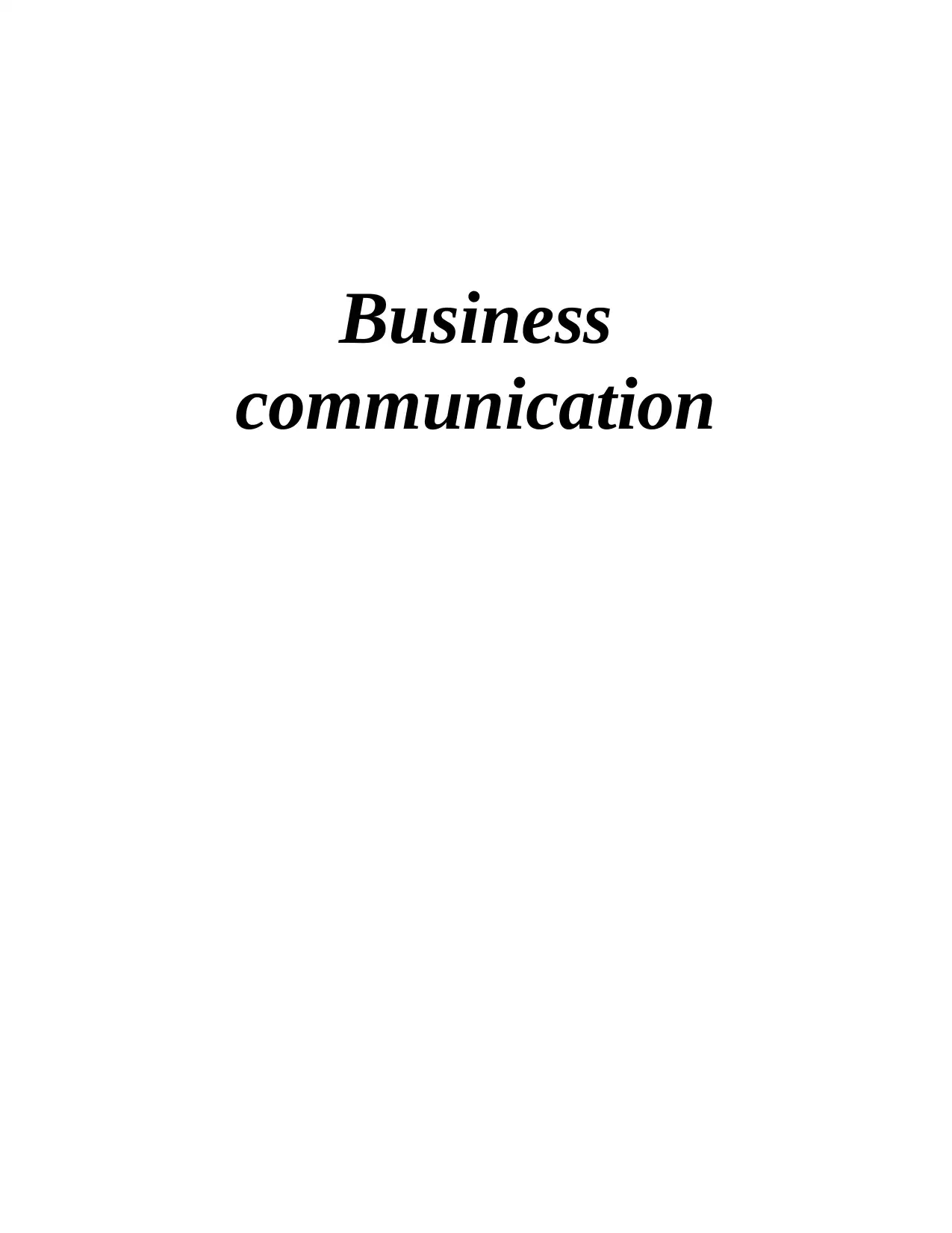
Business
communication
communication
Paraphrase This Document
Need a fresh take? Get an instant paraphrase of this document with our AI Paraphraser
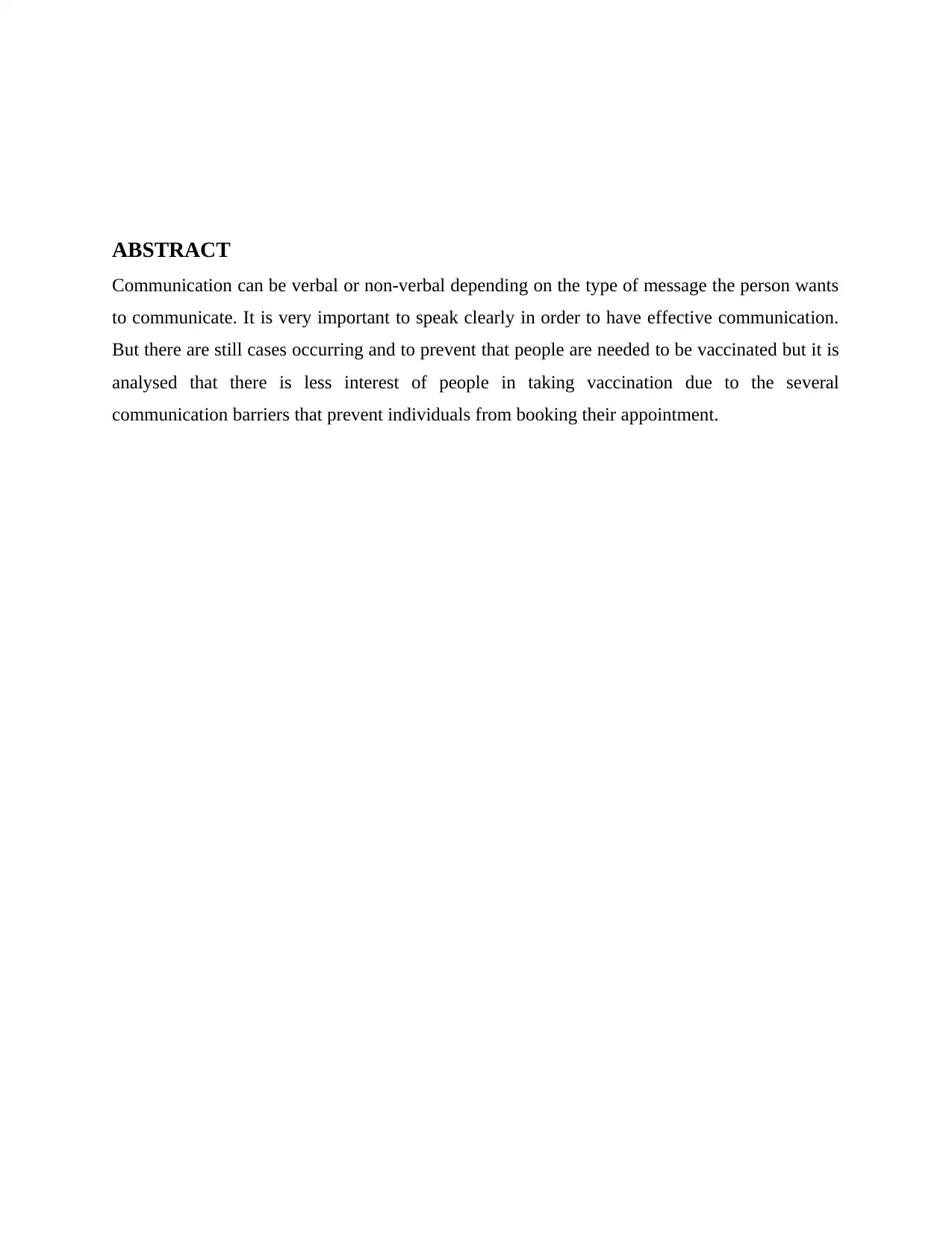
ABSTRACT
Communication can be verbal or non-verbal depending on the type of message the person wants
to communicate. It is very important to speak clearly in order to have effective communication.
But there are still cases occurring and to prevent that people are needed to be vaccinated but it is
analysed that there is less interest of people in taking vaccination due to the several
communication barriers that prevent individuals from booking their appointment.
Communication can be verbal or non-verbal depending on the type of message the person wants
to communicate. It is very important to speak clearly in order to have effective communication.
But there are still cases occurring and to prevent that people are needed to be vaccinated but it is
analysed that there is less interest of people in taking vaccination due to the several
communication barriers that prevent individuals from booking their appointment.
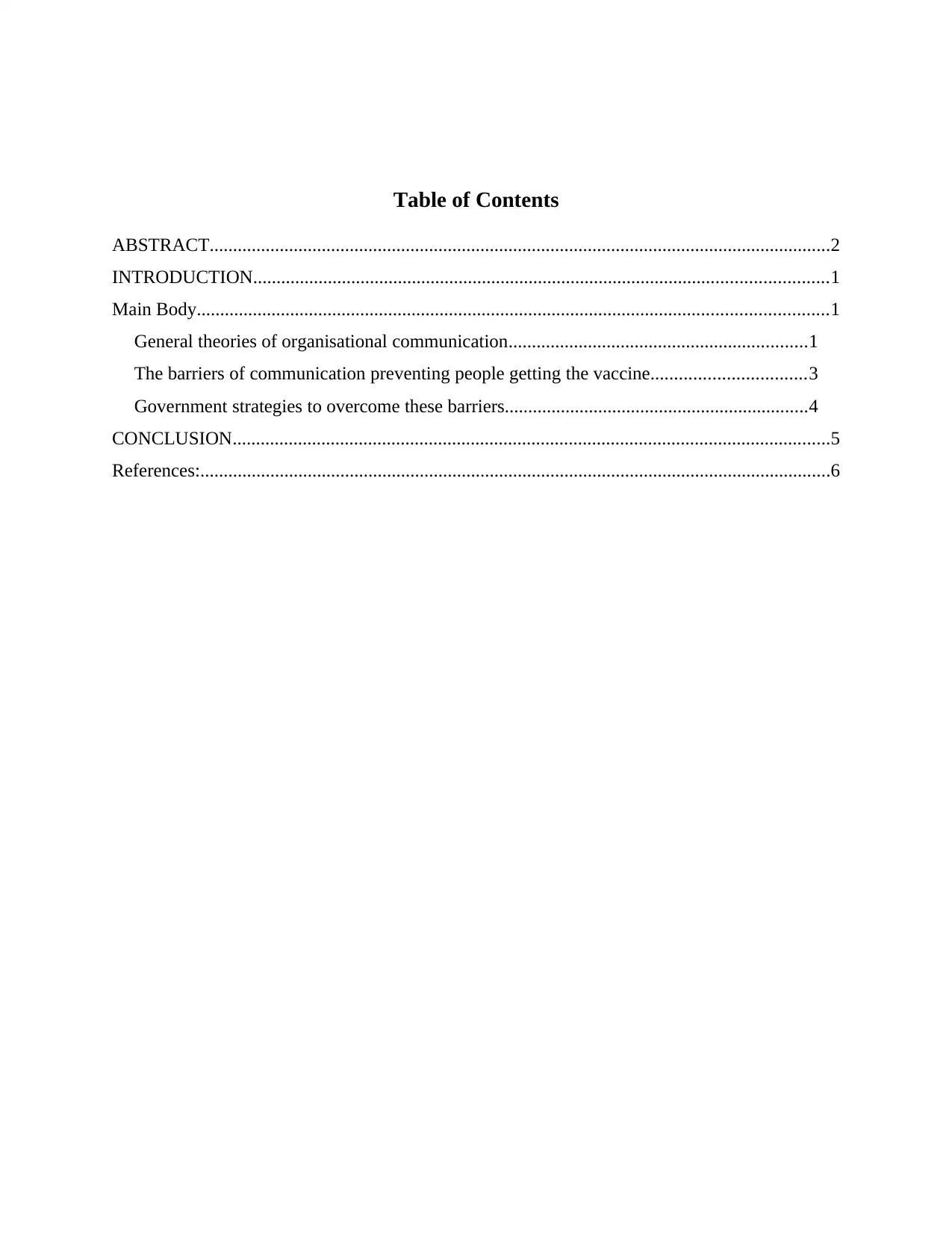
Table of Contents
ABSTRACT.....................................................................................................................................2
INTRODUCTION...........................................................................................................................1
Main Body.......................................................................................................................................1
General theories of organisational communication................................................................1
The barriers of communication preventing people getting the vaccine.................................3
Government strategies to overcome these barriers.................................................................4
CONCLUSION................................................................................................................................5
References:.......................................................................................................................................6
ABSTRACT.....................................................................................................................................2
INTRODUCTION...........................................................................................................................1
Main Body.......................................................................................................................................1
General theories of organisational communication................................................................1
The barriers of communication preventing people getting the vaccine.................................3
Government strategies to overcome these barriers.................................................................4
CONCLUSION................................................................................................................................5
References:.......................................................................................................................................6
⊘ This is a preview!⊘
Do you want full access?
Subscribe today to unlock all pages.

Trusted by 1+ million students worldwide
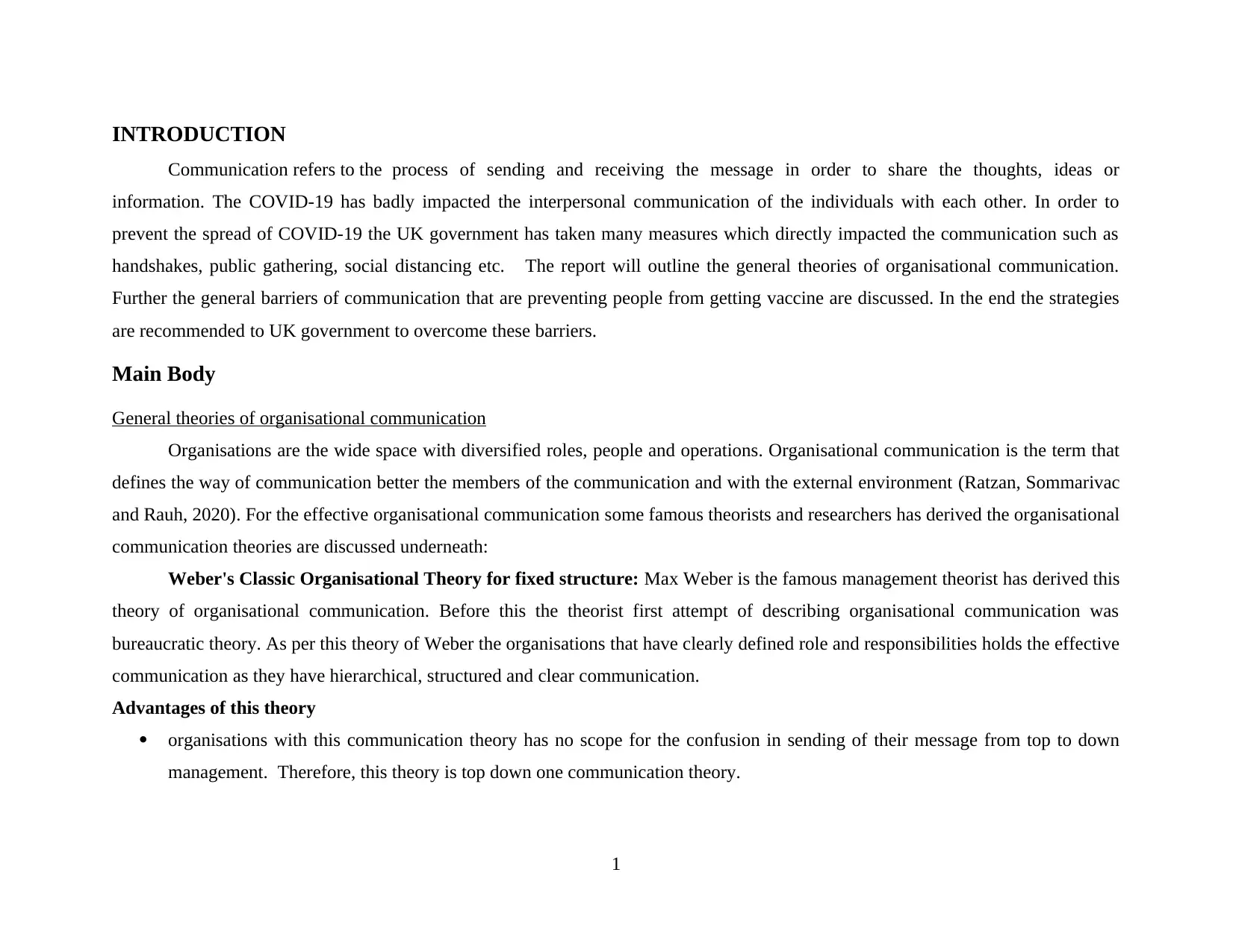
INTRODUCTION
Communication refers to the process of sending and receiving the message in order to share the thoughts, ideas or
information. The COVID-19 has badly impacted the interpersonal communication of the individuals with each other. In order to
prevent the spread of COVID-19 the UK government has taken many measures which directly impacted the communication such as
handshakes, public gathering, social distancing etc. The report will outline the general theories of organisational communication.
Further the general barriers of communication that are preventing people from getting vaccine are discussed. In the end the strategies
are recommended to UK government to overcome these barriers.
Main Body
General theories of organisational communication
Organisations are the wide space with diversified roles, people and operations. Organisational communication is the term that
defines the way of communication better the members of the communication and with the external environment (Ratzan, Sommarivac
and Rauh, 2020). For the effective organisational communication some famous theorists and researchers has derived the organisational
communication theories are discussed underneath:
Weber's Classic Organisational Theory for fixed structure: Max Weber is the famous management theorist has derived this
theory of organisational communication. Before this the theorist first attempt of describing organisational communication was
bureaucratic theory. As per this theory of Weber the organisations that have clearly defined role and responsibilities holds the effective
communication as they have hierarchical, structured and clear communication.
Advantages of this theory
organisations with this communication theory has no scope for the confusion in sending of their message from top to down
management. Therefore, this theory is top down one communication theory.
1
Communication refers to the process of sending and receiving the message in order to share the thoughts, ideas or
information. The COVID-19 has badly impacted the interpersonal communication of the individuals with each other. In order to
prevent the spread of COVID-19 the UK government has taken many measures which directly impacted the communication such as
handshakes, public gathering, social distancing etc. The report will outline the general theories of organisational communication.
Further the general barriers of communication that are preventing people from getting vaccine are discussed. In the end the strategies
are recommended to UK government to overcome these barriers.
Main Body
General theories of organisational communication
Organisations are the wide space with diversified roles, people and operations. Organisational communication is the term that
defines the way of communication better the members of the communication and with the external environment (Ratzan, Sommarivac
and Rauh, 2020). For the effective organisational communication some famous theorists and researchers has derived the organisational
communication theories are discussed underneath:
Weber's Classic Organisational Theory for fixed structure: Max Weber is the famous management theorist has derived this
theory of organisational communication. Before this the theorist first attempt of describing organisational communication was
bureaucratic theory. As per this theory of Weber the organisations that have clearly defined role and responsibilities holds the effective
communication as they have hierarchical, structured and clear communication.
Advantages of this theory
organisations with this communication theory has no scope for the confusion in sending of their message from top to down
management. Therefore, this theory is top down one communication theory.
1
Paraphrase This Document
Need a fresh take? Get an instant paraphrase of this document with our AI Paraphraser
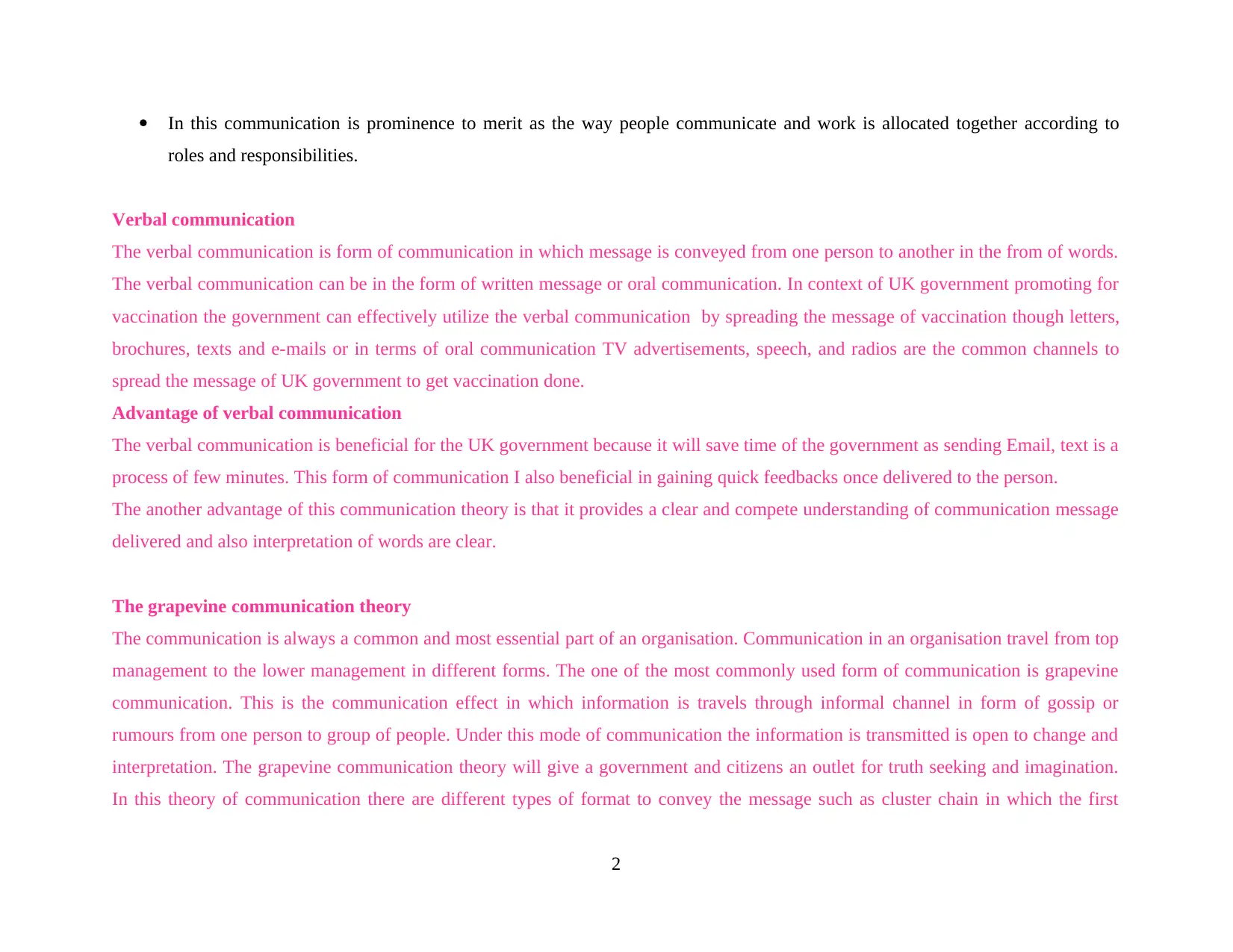
In this communication is prominence to merit as the way people communicate and work is allocated together according to
roles and responsibilities.
Verbal communication
The verbal communication is form of communication in which message is conveyed from one person to another in the from of words.
The verbal communication can be in the form of written message or oral communication. In context of UK government promoting for
vaccination the government can effectively utilize the verbal communication by spreading the message of vaccination though letters,
brochures, texts and e-mails or in terms of oral communication TV advertisements, speech, and radios are the common channels to
spread the message of UK government to get vaccination done.
Advantage of verbal communication
The verbal communication is beneficial for the UK government because it will save time of the government as sending Email, text is a
process of few minutes. This form of communication I also beneficial in gaining quick feedbacks once delivered to the person.
The another advantage of this communication theory is that it provides a clear and compete understanding of communication message
delivered and also interpretation of words are clear.
The grapevine communication theory
The communication is always a common and most essential part of an organisation. Communication in an organisation travel from top
management to the lower management in different forms. The one of the most commonly used form of communication is grapevine
communication. This is the communication effect in which information is travels through informal channel in form of gossip or
rumours from one person to group of people. Under this mode of communication the information is transmitted is open to change and
interpretation. The grapevine communication theory will give a government and citizens an outlet for truth seeking and imagination.
In this theory of communication there are different types of format to convey the message such as cluster chain in which the first
2
roles and responsibilities.
Verbal communication
The verbal communication is form of communication in which message is conveyed from one person to another in the from of words.
The verbal communication can be in the form of written message or oral communication. In context of UK government promoting for
vaccination the government can effectively utilize the verbal communication by spreading the message of vaccination though letters,
brochures, texts and e-mails or in terms of oral communication TV advertisements, speech, and radios are the common channels to
spread the message of UK government to get vaccination done.
Advantage of verbal communication
The verbal communication is beneficial for the UK government because it will save time of the government as sending Email, text is a
process of few minutes. This form of communication I also beneficial in gaining quick feedbacks once delivered to the person.
The another advantage of this communication theory is that it provides a clear and compete understanding of communication message
delivered and also interpretation of words are clear.
The grapevine communication theory
The communication is always a common and most essential part of an organisation. Communication in an organisation travel from top
management to the lower management in different forms. The one of the most commonly used form of communication is grapevine
communication. This is the communication effect in which information is travels through informal channel in form of gossip or
rumours from one person to group of people. Under this mode of communication the information is transmitted is open to change and
interpretation. The grapevine communication theory will give a government and citizens an outlet for truth seeking and imagination.
In this theory of communication there are different types of format to convey the message such as cluster chain in which the first
2
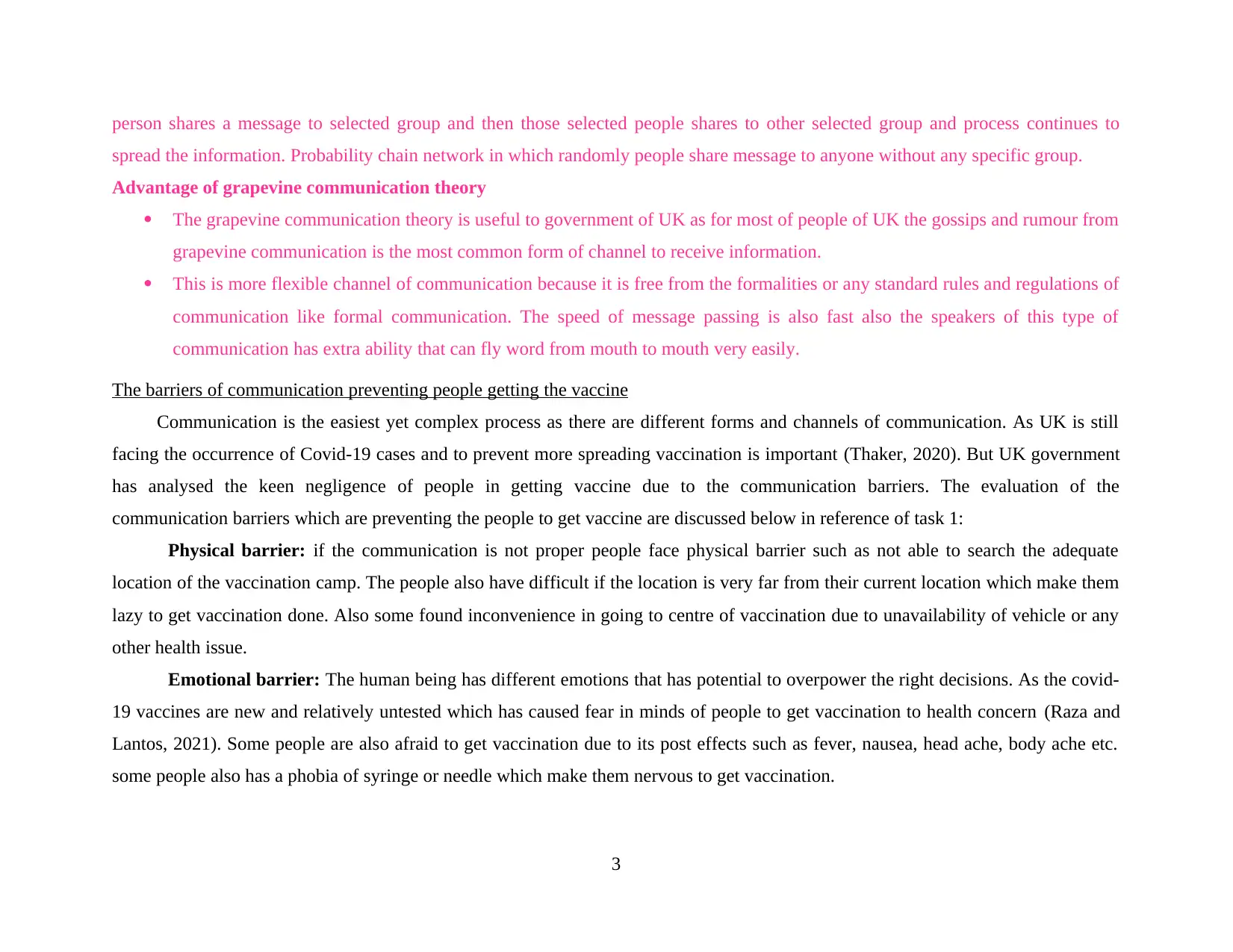
person shares a message to selected group and then those selected people shares to other selected group and process continues to
spread the information. Probability chain network in which randomly people share message to anyone without any specific group.
Advantage of grapevine communication theory
The grapevine communication theory is useful to government of UK as for most of people of UK the gossips and rumour from
grapevine communication is the most common form of channel to receive information.
This is more flexible channel of communication because it is free from the formalities or any standard rules and regulations of
communication like formal communication. The speed of message passing is also fast also the speakers of this type of
communication has extra ability that can fly word from mouth to mouth very easily.
The barriers of communication preventing people getting the vaccine
Communication is the easiest yet complex process as there are different forms and channels of communication. As UK is still
facing the occurrence of Covid-19 cases and to prevent more spreading vaccination is important (Thaker, 2020). But UK government
has analysed the keen negligence of people in getting vaccine due to the communication barriers. The evaluation of the
communication barriers which are preventing the people to get vaccine are discussed below in reference of task 1:
Physical barrier: if the communication is not proper people face physical barrier such as not able to search the adequate
location of the vaccination camp. The people also have difficult if the location is very far from their current location which make them
lazy to get vaccination done. Also some found inconvenience in going to centre of vaccination due to unavailability of vehicle or any
other health issue.
Emotional barrier: The human being has different emotions that has potential to overpower the right decisions. As the covid-
19 vaccines are new and relatively untested which has caused fear in minds of people to get vaccination to health concern (Raza and
Lantos, 2021). Some people are also afraid to get vaccination due to its post effects such as fever, nausea, head ache, body ache etc.
some people also has a phobia of syringe or needle which make them nervous to get vaccination.
3
spread the information. Probability chain network in which randomly people share message to anyone without any specific group.
Advantage of grapevine communication theory
The grapevine communication theory is useful to government of UK as for most of people of UK the gossips and rumour from
grapevine communication is the most common form of channel to receive information.
This is more flexible channel of communication because it is free from the formalities or any standard rules and regulations of
communication like formal communication. The speed of message passing is also fast also the speakers of this type of
communication has extra ability that can fly word from mouth to mouth very easily.
The barriers of communication preventing people getting the vaccine
Communication is the easiest yet complex process as there are different forms and channels of communication. As UK is still
facing the occurrence of Covid-19 cases and to prevent more spreading vaccination is important (Thaker, 2020). But UK government
has analysed the keen negligence of people in getting vaccine due to the communication barriers. The evaluation of the
communication barriers which are preventing the people to get vaccine are discussed below in reference of task 1:
Physical barrier: if the communication is not proper people face physical barrier such as not able to search the adequate
location of the vaccination camp. The people also have difficult if the location is very far from their current location which make them
lazy to get vaccination done. Also some found inconvenience in going to centre of vaccination due to unavailability of vehicle or any
other health issue.
Emotional barrier: The human being has different emotions that has potential to overpower the right decisions. As the covid-
19 vaccines are new and relatively untested which has caused fear in minds of people to get vaccination to health concern (Raza and
Lantos, 2021). Some people are also afraid to get vaccination due to its post effects such as fever, nausea, head ache, body ache etc.
some people also has a phobia of syringe or needle which make them nervous to get vaccination.
3
⊘ This is a preview!⊘
Do you want full access?
Subscribe today to unlock all pages.

Trusted by 1+ million students worldwide
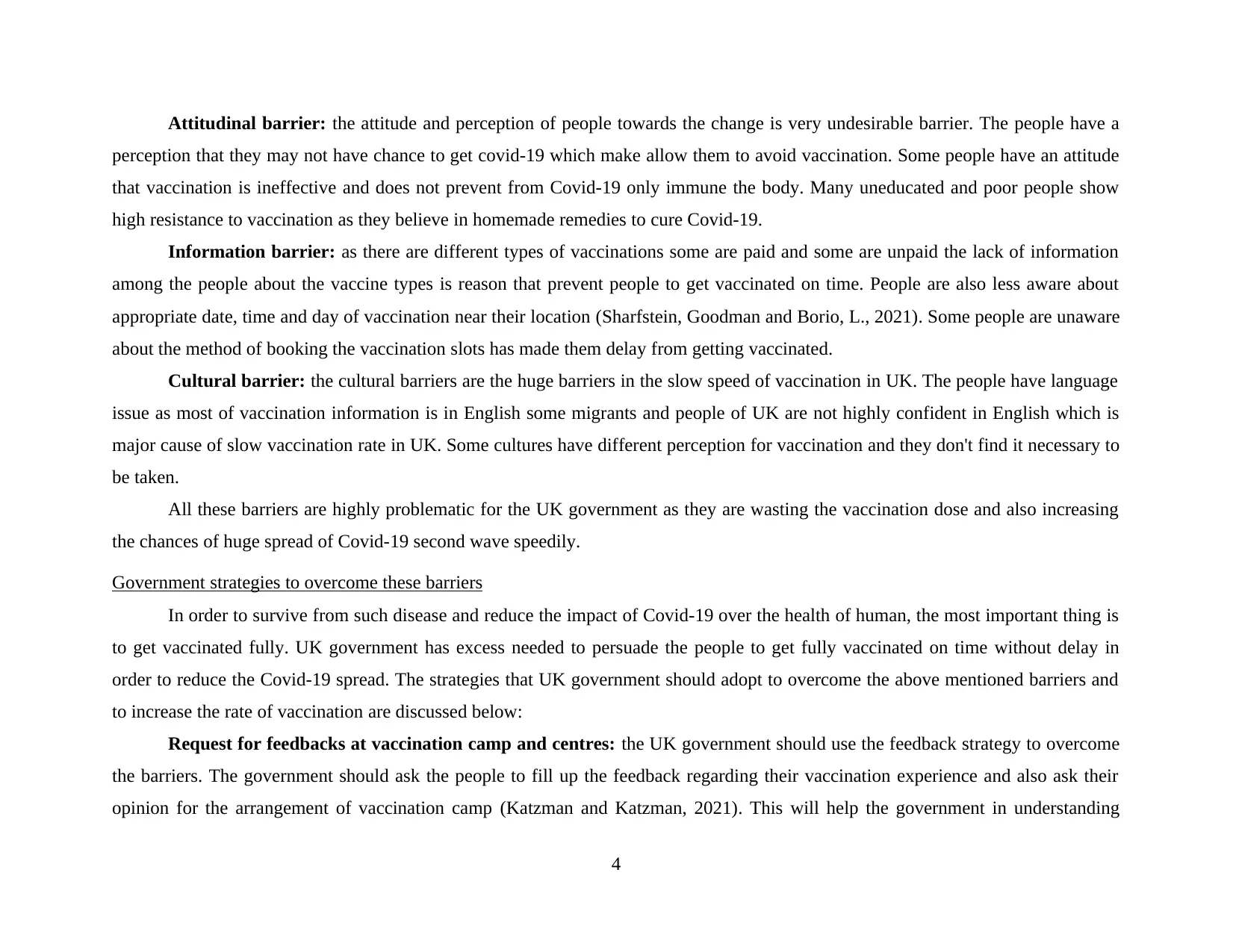
Attitudinal barrier: the attitude and perception of people towards the change is very undesirable barrier. The people have a
perception that they may not have chance to get covid-19 which make allow them to avoid vaccination. Some people have an attitude
that vaccination is ineffective and does not prevent from Covid-19 only immune the body. Many uneducated and poor people show
high resistance to vaccination as they believe in homemade remedies to cure Covid-19.
Information barrier: as there are different types of vaccinations some are paid and some are unpaid the lack of information
among the people about the vaccine types is reason that prevent people to get vaccinated on time. People are also less aware about
appropriate date, time and day of vaccination near their location (Sharfstein, Goodman and Borio, L., 2021). Some people are unaware
about the method of booking the vaccination slots has made them delay from getting vaccinated.
Cultural barrier: the cultural barriers are the huge barriers in the slow speed of vaccination in UK. The people have language
issue as most of vaccination information is in English some migrants and people of UK are not highly confident in English which is
major cause of slow vaccination rate in UK. Some cultures have different perception for vaccination and they don't find it necessary to
be taken.
All these barriers are highly problematic for the UK government as they are wasting the vaccination dose and also increasing
the chances of huge spread of Covid-19 second wave speedily.
Government strategies to overcome these barriers
In order to survive from such disease and reduce the impact of Covid-19 over the health of human, the most important thing is
to get vaccinated fully. UK government has excess needed to persuade the people to get fully vaccinated on time without delay in
order to reduce the Covid-19 spread. The strategies that UK government should adopt to overcome the above mentioned barriers and
to increase the rate of vaccination are discussed below:
Request for feedbacks at vaccination camp and centres: the UK government should use the feedback strategy to overcome
the barriers. The government should ask the people to fill up the feedback regarding their vaccination experience and also ask their
opinion for the arrangement of vaccination camp (Katzman and Katzman, 2021). This will help the government in understanding
4
perception that they may not have chance to get covid-19 which make allow them to avoid vaccination. Some people have an attitude
that vaccination is ineffective and does not prevent from Covid-19 only immune the body. Many uneducated and poor people show
high resistance to vaccination as they believe in homemade remedies to cure Covid-19.
Information barrier: as there are different types of vaccinations some are paid and some are unpaid the lack of information
among the people about the vaccine types is reason that prevent people to get vaccinated on time. People are also less aware about
appropriate date, time and day of vaccination near their location (Sharfstein, Goodman and Borio, L., 2021). Some people are unaware
about the method of booking the vaccination slots has made them delay from getting vaccinated.
Cultural barrier: the cultural barriers are the huge barriers in the slow speed of vaccination in UK. The people have language
issue as most of vaccination information is in English some migrants and people of UK are not highly confident in English which is
major cause of slow vaccination rate in UK. Some cultures have different perception for vaccination and they don't find it necessary to
be taken.
All these barriers are highly problematic for the UK government as they are wasting the vaccination dose and also increasing
the chances of huge spread of Covid-19 second wave speedily.
Government strategies to overcome these barriers
In order to survive from such disease and reduce the impact of Covid-19 over the health of human, the most important thing is
to get vaccinated fully. UK government has excess needed to persuade the people to get fully vaccinated on time without delay in
order to reduce the Covid-19 spread. The strategies that UK government should adopt to overcome the above mentioned barriers and
to increase the rate of vaccination are discussed below:
Request for feedbacks at vaccination camp and centres: the UK government should use the feedback strategy to overcome
the barriers. The government should ask the people to fill up the feedback regarding their vaccination experience and also ask their
opinion for the arrangement of vaccination camp (Katzman and Katzman, 2021). This will help the government in understanding
4
Paraphrase This Document
Need a fresh take? Get an instant paraphrase of this document with our AI Paraphraser
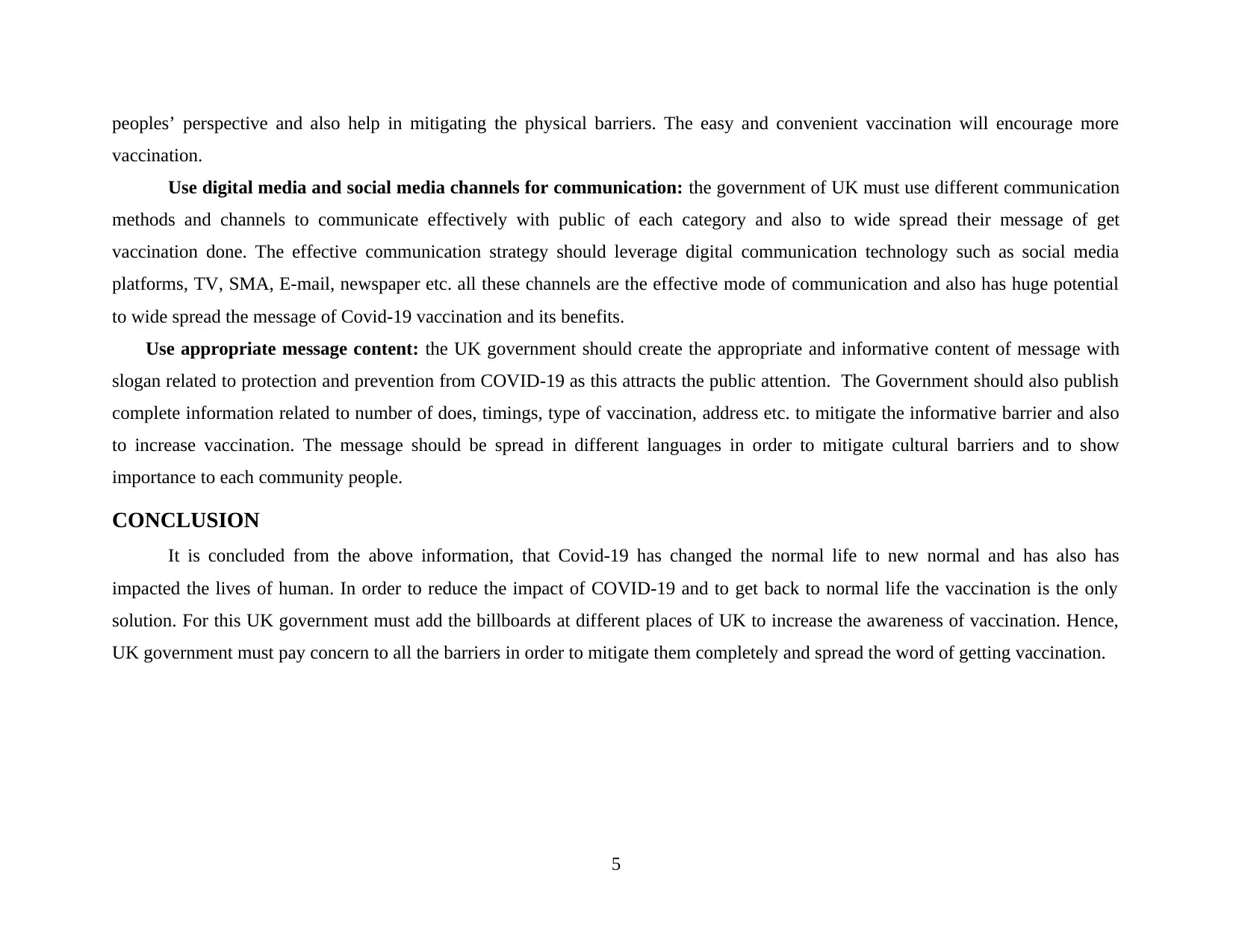
peoples’ perspective and also help in mitigating the physical barriers. The easy and convenient vaccination will encourage more
vaccination.
Use digital media and social media channels for communication: the government of UK must use different communication
methods and channels to communicate effectively with public of each category and also to wide spread their message of get
vaccination done. The effective communication strategy should leverage digital communication technology such as social media
platforms, TV, SMA, E-mail, newspaper etc. all these channels are the effective mode of communication and also has huge potential
to wide spread the message of Covid-19 vaccination and its benefits.
Use appropriate message content: the UK government should create the appropriate and informative content of message with
slogan related to protection and prevention from COVID-19 as this attracts the public attention. The Government should also publish
complete information related to number of does, timings, type of vaccination, address etc. to mitigate the informative barrier and also
to increase vaccination. The message should be spread in different languages in order to mitigate cultural barriers and to show
importance to each community people.
CONCLUSION
It is concluded from the above information, that Covid-19 has changed the normal life to new normal and has also has
impacted the lives of human. In order to reduce the impact of COVID-19 and to get back to normal life the vaccination is the only
solution. For this UK government must add the billboards at different places of UK to increase the awareness of vaccination. Hence,
UK government must pay concern to all the barriers in order to mitigate them completely and spread the word of getting vaccination.
5
vaccination.
Use digital media and social media channels for communication: the government of UK must use different communication
methods and channels to communicate effectively with public of each category and also to wide spread their message of get
vaccination done. The effective communication strategy should leverage digital communication technology such as social media
platforms, TV, SMA, E-mail, newspaper etc. all these channels are the effective mode of communication and also has huge potential
to wide spread the message of Covid-19 vaccination and its benefits.
Use appropriate message content: the UK government should create the appropriate and informative content of message with
slogan related to protection and prevention from COVID-19 as this attracts the public attention. The Government should also publish
complete information related to number of does, timings, type of vaccination, address etc. to mitigate the informative barrier and also
to increase vaccination. The message should be spread in different languages in order to mitigate cultural barriers and to show
importance to each community people.
CONCLUSION
It is concluded from the above information, that Covid-19 has changed the normal life to new normal and has also has
impacted the lives of human. In order to reduce the impact of COVID-19 and to get back to normal life the vaccination is the only
solution. For this UK government must add the billboards at different places of UK to increase the awareness of vaccination. Hence,
UK government must pay concern to all the barriers in order to mitigate them completely and spread the word of getting vaccination.
5
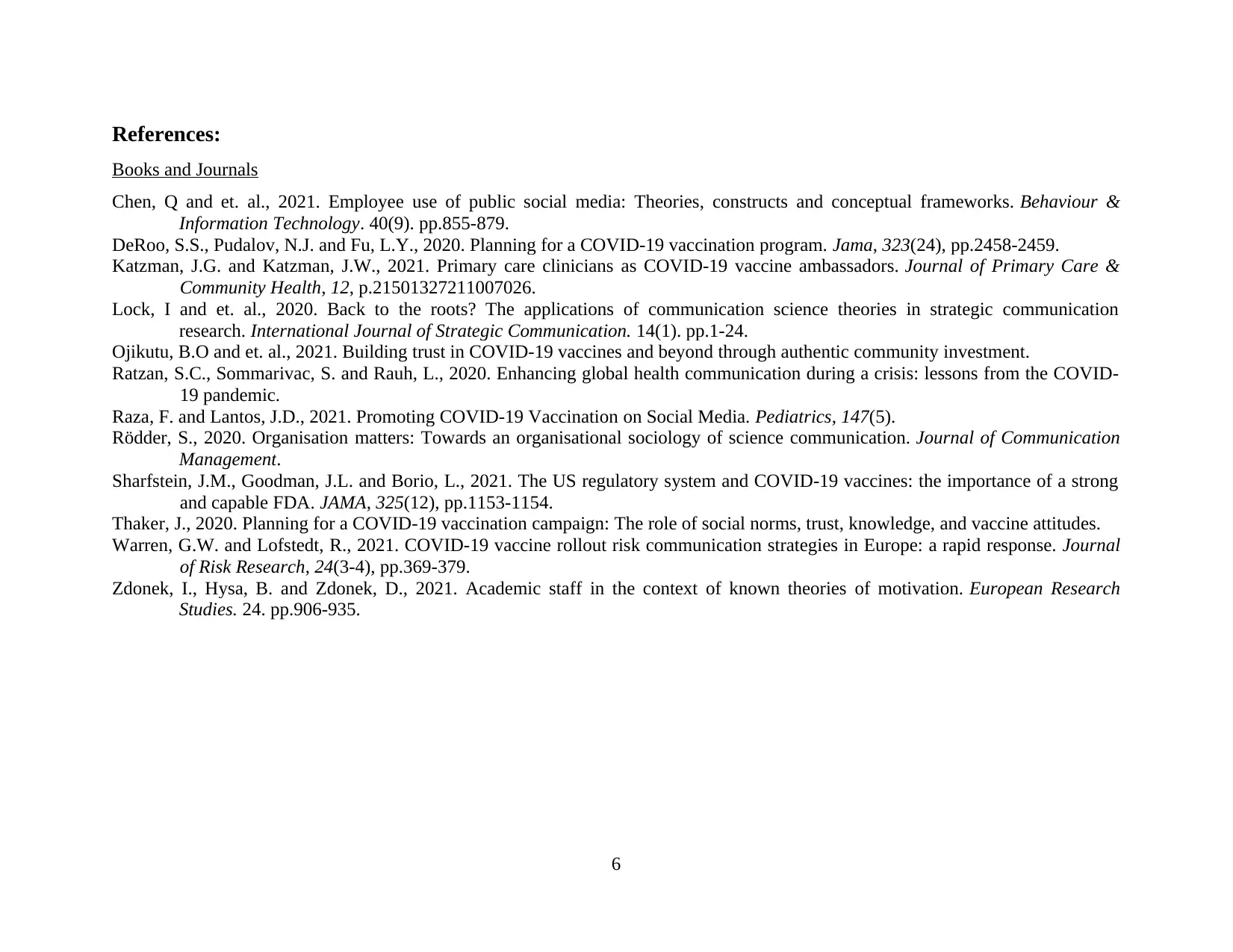
References:
Books and Journals
Chen, Q and et. al., 2021. Employee use of public social media: Theories, constructs and conceptual frameworks. Behaviour &
Information Technology. 40(9). pp.855-879.
DeRoo, S.S., Pudalov, N.J. and Fu, L.Y., 2020. Planning for a COVID-19 vaccination program. Jama, 323(24), pp.2458-2459.
Katzman, J.G. and Katzman, J.W., 2021. Primary care clinicians as COVID-19 vaccine ambassadors. Journal of Primary Care &
Community Health, 12, p.21501327211007026.
Lock, I and et. al., 2020. Back to the roots? The applications of communication science theories in strategic communication
research. International Journal of Strategic Communication. 14(1). pp.1-24.
Ojikutu, B.O and et. al., 2021. Building trust in COVID-19 vaccines and beyond through authentic community investment.
Ratzan, S.C., Sommarivac, S. and Rauh, L., 2020. Enhancing global health communication during a crisis: lessons from the COVID-
19 pandemic.
Raza, F. and Lantos, J.D., 2021. Promoting COVID-19 Vaccination on Social Media. Pediatrics, 147(5).
Rödder, S., 2020. Organisation matters: Towards an organisational sociology of science communication. Journal of Communication
Management.
Sharfstein, J.M., Goodman, J.L. and Borio, L., 2021. The US regulatory system and COVID-19 vaccines: the importance of a strong
and capable FDA. JAMA, 325(12), pp.1153-1154.
Thaker, J., 2020. Planning for a COVID-19 vaccination campaign: The role of social norms, trust, knowledge, and vaccine attitudes.
Warren, G.W. and Lofstedt, R., 2021. COVID-19 vaccine rollout risk communication strategies in Europe: a rapid response. Journal
of Risk Research, 24(3-4), pp.369-379.
Zdonek, I., Hysa, B. and Zdonek, D., 2021. Academic staff in the context of known theories of motivation. European Research
Studies. 24. pp.906-935.
6
Books and Journals
Chen, Q and et. al., 2021. Employee use of public social media: Theories, constructs and conceptual frameworks. Behaviour &
Information Technology. 40(9). pp.855-879.
DeRoo, S.S., Pudalov, N.J. and Fu, L.Y., 2020. Planning for a COVID-19 vaccination program. Jama, 323(24), pp.2458-2459.
Katzman, J.G. and Katzman, J.W., 2021. Primary care clinicians as COVID-19 vaccine ambassadors. Journal of Primary Care &
Community Health, 12, p.21501327211007026.
Lock, I and et. al., 2020. Back to the roots? The applications of communication science theories in strategic communication
research. International Journal of Strategic Communication. 14(1). pp.1-24.
Ojikutu, B.O and et. al., 2021. Building trust in COVID-19 vaccines and beyond through authentic community investment.
Ratzan, S.C., Sommarivac, S. and Rauh, L., 2020. Enhancing global health communication during a crisis: lessons from the COVID-
19 pandemic.
Raza, F. and Lantos, J.D., 2021. Promoting COVID-19 Vaccination on Social Media. Pediatrics, 147(5).
Rödder, S., 2020. Organisation matters: Towards an organisational sociology of science communication. Journal of Communication
Management.
Sharfstein, J.M., Goodman, J.L. and Borio, L., 2021. The US regulatory system and COVID-19 vaccines: the importance of a strong
and capable FDA. JAMA, 325(12), pp.1153-1154.
Thaker, J., 2020. Planning for a COVID-19 vaccination campaign: The role of social norms, trust, knowledge, and vaccine attitudes.
Warren, G.W. and Lofstedt, R., 2021. COVID-19 vaccine rollout risk communication strategies in Europe: a rapid response. Journal
of Risk Research, 24(3-4), pp.369-379.
Zdonek, I., Hysa, B. and Zdonek, D., 2021. Academic staff in the context of known theories of motivation. European Research
Studies. 24. pp.906-935.
6
⊘ This is a preview!⊘
Do you want full access?
Subscribe today to unlock all pages.

Trusted by 1+ million students worldwide
1 out of 9
Related Documents
Your All-in-One AI-Powered Toolkit for Academic Success.
+13062052269
info@desklib.com
Available 24*7 on WhatsApp / Email
![[object Object]](/_next/static/media/star-bottom.7253800d.svg)
Unlock your academic potential
Copyright © 2020–2025 A2Z Services. All Rights Reserved. Developed and managed by ZUCOL.





